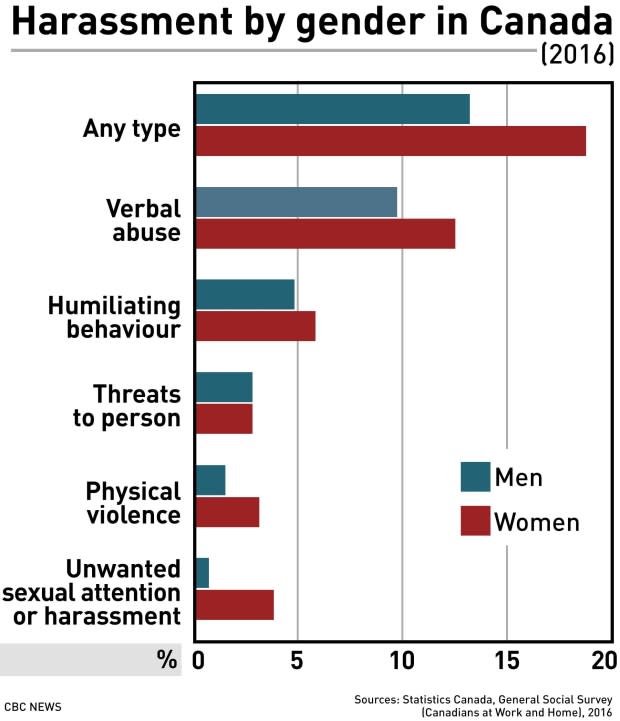19% of women, 13% of men report workplace harassment in StatsCan survey
About 19 per cent of Canadian women and 13 per cent of men reported being harassed in the workplace, with the highest level of harassment in health-care jobs, according to Statistics Canada.
Verbal abuse was the most common form of harassment for both men and women with 13 per cent of women and 10 per cent of men reporting they'd experienced abuse in the preceding year.
Sexual harassment was most likely to affect women, with four per cent saying they had experienced unwanted sexual attention in the workplace, compared to fewer than one per cent of men.
Young, unmarried women were most likely to report some form of sexual harassment.

The results, based on Statistics Canada's General Social Survey, gathered data in 2016, the year before the #MeToo movement focused attention on sexual harassment. The report was released Monday.
"That's why we have to follow up," said Sébastien LaRochelle-Côté, a managing editor for Statistics Canada, who says researchers have suggested repeating the survey amid the more heightened awareness of harassment that followed #MeToo.
The survey conducted from August to December 2016 questioned 19,609 men and women aged 15 to 64, who had worked for pay in the preceding year.
Harassment from clients, customers
LaRochelle-Côté said survey questions asked people whether they had experienced verbal abuse, humiliating behaviour, threats, physical violence, and unwanted sexual attention or sexual harassment in the workplace in the past year.
"It doesn't mean they reported the situation to their employer," he said.
About 53 per cent of women said the harassment came from a client or a customer at work. compared with 42 per cent of men.

"A lot of people who work with the public — and that includes, for example, people who work in health-care occupations — have higher levels of harassment because they have higher levels of interaction with the public," LaRochelle-Côté said.
People working in the health-care related jobs experienced the highest levels of harassment, with about 23 per cent reporting they had been harassed in the past year.
In health occupations, including doctors and nurses, 27 per cent of women and 21 per cent of men reported harassment in the past year.
Part of the reason for higher levels of harassment of women is that more of them work in health-related jobs, he said.
Michael Hurley, president of the Ontario Council of Hospital Unions, says he thinks Statistics Canada's numbers are low. A survey the council did earlier this year found 68 per cent of hospital staff in Ontario said they have been victims of physical violence at work in the past year.
"Negative attitudes toward women are imported by family members," he told CBC News. "Low levels of staffing and quality-of-care issues combine together to create a situation where people feel free to express the anger they have."
He recommends an increase in staffing because too many health-care workers are on their own in both nursing homes and hospitals.
Hurley said his union is pressing for a change in the criminal code to increase sentences for people who assault health-care workers.
It's also urging some means of flagging troublesome patients and warning nurses and doctors about patients involved with law enforcement, to help them know they must be extra cautious. Earlier this year in Kingston, Ont., a prison inmate disarmed an officer and fired two shots in the hospital.
Among men, 39 per cent of those reporting harassment in the Statistics Canada survey said they'd been harassed by a supervisor or manager, while among women, more — 34 per cent — said they'd been harassed by peers or colleagues.
The survey found that being harassed at work was associated with stress, poor mental health and lack of motivation.
"It does have implications for employers if you look at the higher proportion of workers who've been harassed who want to leave their jobs and even more so if they've been harassed by a person in a position of power," LaRochelle-Côté said.
About 47 per cent of men and 34 per cent of women who had been harassed by a supervisor or manager reported a weak sense of belonging to their current organization, compared with 16 per cent of both women and men who said they had not been harassed at work in the past year.

 Yahoo Finance
Yahoo Finance 